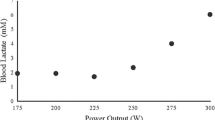Summary
During this study the relationships between venous lactate concentration and associated changes in respiratory gas exchange were investigated. Five men performed two successive incremental exercise tests to exhaustion on an electronically braked cycle ergometer. These tests were separated by a 5 min rest period. During the initial test venous lactate concentrations showed a characteristic curvilinear increase and the anaerobic threshold (AT1) was determined conventionally. During the second test lactate concentrations were still decreasing at higher work rates than the AT1, and a second anaerobic threshold (AT2) was determined as the point where lactate concentrations again increased. The departure from linearity of the ventilatory response to both exercise tests occurred at a similar work rate, irrespective of whether venous lactate concentrations were increasing or decreasing. Carbon dioxide production was similar during the two exercise tests. The anaerobic thresholds as determined by respiratory gas analysis (ATR) were therefore similar for both tests. Results of this study indicate that changing venous lactate concentrations were not responsible for the ventilatory drive which occurred at the ATR. The venous lactate response to work at a constant rate determined within the range AT1–AT2 was also investigated. It was concluded that the lactate response to constant work rate will vary predictably at work rates falling within the AT1 to AT2 range. At AT1 no increase in venous lactate concentrations occurred, while at AT2 these increased progressively, and the test was terminated at varying times (12–15 min) due to subject exhaustion. At work rates determined from the ATR venous lactate concentrations varied according to the placement of the ATR within the AT1 AT2 range.
Similar content being viewed by others
References
Benade AJS, Heisler N (1978) Comparison of efflux rates of hydrogen and lactate ions from isolated muscle in vitro. Respir Physiol 32: 369–380
Davis JA (1979) Symposium on ventilatory control during exercise. Med Sci Sports 11: 190
Davis JA, Frank MH, Whipp BJ, Wasserman K (1979) Anaerobic threshold alterations caused by endurance training in middle aged men. J Appl Physiol 46: 1039–1046
Davis HA, Gass GC (1979) Blood lactate concentrations during incremental work before and after maximum exercise. Br J Sports Med 13: 165–169
Davis JA, Vodak P, Wilmore JH, Vodak J, Kurtz P (1976) Anaerobic threshold and maximal aerobic power for three modes of exercise. J Appl Physiol 41: 544–550
Gollnick PD, Hermansen L (1973) Biochemical adaptations to exercise: anaerobic metabolism. Exerc Sport Sci Rev 1: 1–43
Hermansen L, Vaage O (1977) Lactate disappearance and glycogen synthesis in human muscle after maximal exercise. Am J Physiol 233: E422-E429
Hermansen L (1969) Anaerobic energy release. Med Sci Sports 1: 32–38
Levine S (1979) Ventilatory response to muscular exercise: observations regarding a humoral pathway. J Appl Physiol 47: 126–137
Nagle F, Robinhold D, Howley E, Daniels J, Baptista G, Stoedefalke K (1970) Lactic acid accumulation during running at submaximal aerobic demands. Med Sci Sports 2: 182–186
Pitts FN, McClure JN (1967) Lactate metabolism in anxiety neurosis. N Engl J Med 277: 1329–1336
Racine P, Klenk HO, Kochsiek K (1975) Rapid lactate determination with an electrochemical enzymatic sensor: clinical usability and comparative measurements. J Clin Chem Clin Biochem 13: 533–539
Ritz E, Heidland A (1977) Lactic acidosis. Clin Nephrol 7: 231–240
Sahlin K (1978) Intracellular pH and energy metabolism in skeletal muscle of man. Acta Physiol Scand [Suppl] 455: 1–53
Stamford BA, Weltman A, Fulco C (1978) Anaerobic threshold and cardiovascular responses during one- versus two-legged cycling. Res Q Am Assoc Health Phys Educ 49: 351–362
Sutton JR, Jones NL (1979) Control of pulmonary ventilation during exercise and mediators in the blood: CO2 and hydrogen ion. Med Sci Sports 11: 198–203
Wasserman K, McIlroy MB (1964) Detecting the threshold of anaerobic metabolism in cardiac patients' during exercise. Am J Cardiol 14: 844–852
Wasserman K, Whipp BJ (1975) Exercise physiology in health and disease. Am Rev Respir Dis 112: 219–249
Wasserman K, Whipp BJ, Koyal SN, Beaver WL (1973) Anaerobic threshold and respiratory gas exchange during exercise. J Appl Physiol 35: 236–243
Whipp BJ, Davis JA (1979) Peripheral chemoreceptors and exercise hyperpnoea. Med Sci Sports 11: 204–212
Author information
Authors and Affiliations
Rights and permissions
About this article
Cite this article
Davis, H.A., Gass, G.C. The anaerobic threshold as determined before and during lactic acidosis. Europ. J. Appl. Physiol. 47, 141–149 (1981). https://doi.org/10.1007/BF00421666
Accepted:
Issue Date:
DOI: https://doi.org/10.1007/BF00421666




